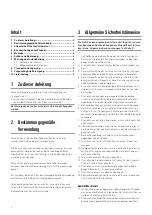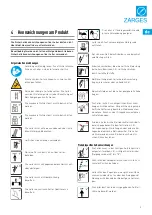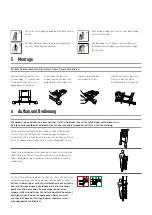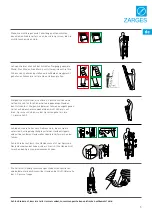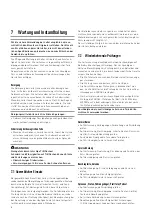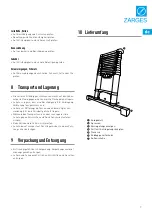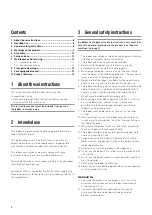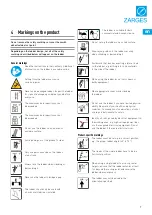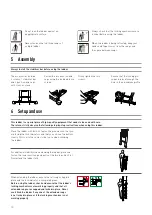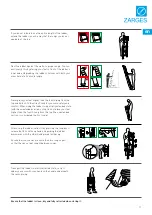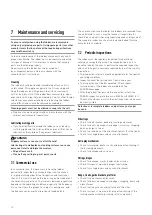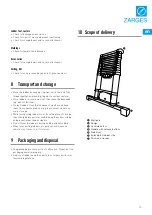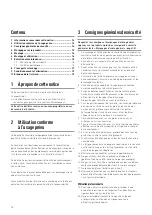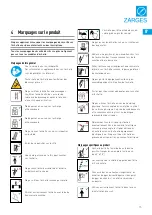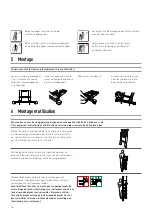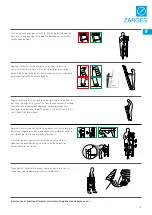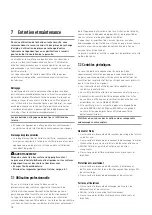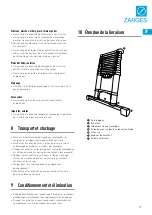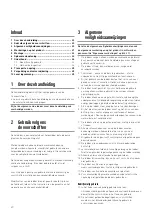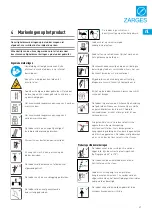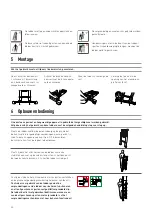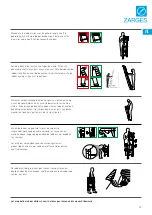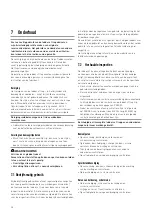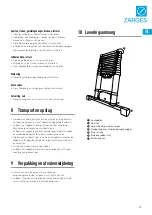
12
7 Maintenance and servicing
To ensure safety when using the ladder, we recommend
using only original spare parts. Using spare parts from other
manufacturers that do not meet the required specifications
may void the warranty.
Care and maintenance of the ladder are meant to ensure its
proper functioning. The ladder has to be regularly inspected
for signs of damage. It is necessary to ensure that moving
parts are functioning properly.
Repair work on the ladder has to be carried out
by a competent person and in accordance with the
manufacturer's instructions.
Cleaning
The ladder should be cleaned immediately after use if it is
visibly soiled. This applies especially to all its moving parts.
Keep the ladder clean. Wipe down the stiles occasionally
with a clean, dry cloth. If the ladder becomes wet (e.g. when
exposed to rain), wipe it dry immediately. Paint or other foreign
substances may make extending and retracting the ladder
more difficult and should be removed immediately.
Cleaning agents must not be allowed to seep into the soil.
• Dispose of used cleaning solutions in accordance with the
relevant environmental regulations.
Lubricating moving parts
• If you find it difficult to extend the ladder, use a clean dry
cloth to wipe down the stiles and then spray a little silicone
lubricant on them (wipe off any excess lubricant).
WARNING
Slippery surfaces are a source of fall hazard!
Lubricating oil and liquids on standing surfaces can cause
personnel to fall and injure themselves.
• Wipe off excess oil.
• Clean off any soiling (e.g. wet paint, snow).
7.1 Commercial use
In commercial use, it is necessary to have the ladder
periodically inspected by a competent person to ensure it
is in good working order (visual inspection and functional
check). It is crucial to define the type, scope and schedule of
the necessary inspections. The intervals between inspections
depend on the operating conditions, especially the frequency
of use, the stress the product is subject to during use, and
the frequency and severity of previously found defects.
The user must ensure that defective ladders are removed from
use and stored in such a way that makes it impossible for
them to be used until they are properly repaired or disposed of.
The complete inspection sheet can be downloaded from the
manufacturer's website.
7.2 Periodic inspections
The ladder must be regularly inspected for operational
safety by a competent person. The competent person is to
be authorised by the user to perform the required inspection
and shall take part in seminars required by law of the country
in question.
• The inspection intervals must be appropriate for the specific
operating conditions.
• Inspection must be carried out at least once a year.
• The inspection must be documented. Check sheets
for inspection of the ladder are available on the
ZARGES homepage.
• After the product has passed the inspection, attach the
ZARGES inspection plate (order no. 828384 or 828385) to it.
The month and year in which the next inspection is due must
be clearly visible.
Defective or incomplete ladders and parts may no longer
be used.
Stiles/legs
• Check for deformation, bending, twisting and cracks.
• Check for dents, damage, sharp edges, corrosion, chipping,
burrs and signs of wear.
• Check the condition of the attachment points for other parts.
• Check for completeness and secure attachment.
Anti-splay mechanism
• Check for warping, dents, cracks and proper functioning of
the fastening elements.
• Check for damage and corrosion.
Fittings, hinges
• Check for damage, cracks, bends and corrosion.
• Check for signs of wear and proper functioning.
• Check for completeness and secure attachment.
Rungs, treads, guide brackets, platform
• Check for deformation and cracks.
• Check for dents, damage, sharp edges, chipping, burrs and
signs of wear.
• Check that they are securely attached to the stiles.
• Check for signs of wear and for proper functioning of the
locking mechanisms (e.g. locking latch, rung hook).


